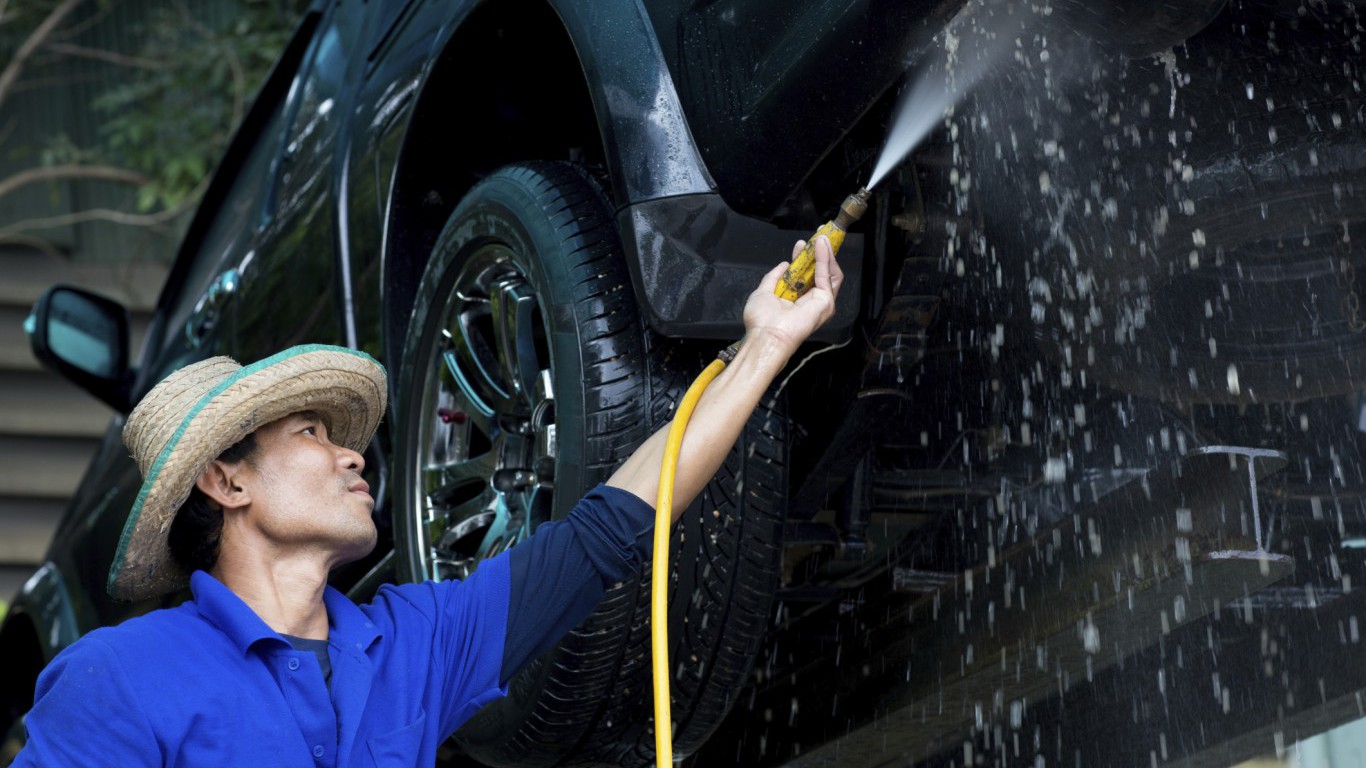Special Report
12 Occupations With the Worst Job Security

Published:
Last Updated:

Every month, millions of Americans leave their jobs, either because they are laid off or because they quit. While most American workers likely seek stable, long-term employment, millions of U.S. jobs are relatively unstable.
Many occupations have high turnover or are unstable either because the work is seasonal or temporary, the industry is downsizing, or the jobs are so undesirable that workers tend to quit. While the U.S. unemployment rate is 4.4%, the jobless rate is greater than 10% in 12 occupations.
[in-text-ad]
A number of positions on this list require little to no formal education and have minimal additional on-the-job training. This includes jobs such as dishwashers, freight and stock laborers, hand packers, and cleaners. Fewer job requirements may mean employers consider these employees replaceable. Some workers who last held several of these low-skilled jobs may be unemployed because the work is strenuous.
Click here to see the 12 occupations with the worst job security.
These jobs also tend to pay very poorly, which is both evidence of the the low skill requirements, and also likely a reason workers leave these jobs. Of the 11 jobs on this list with available wage data, all earn less than the average annual U.S. wage of $48,320. Many of these occupations have average annual wages of less than $25,000.
While many of the most stable jobs — those with the lowest unemployment rates — tend to employ older Americans, the majority of the least stable jobs are entry-level positions, which often have high turnover as people are more likely to leave for better opportunities. The typical U.S. worker is 42.3 years old, but the median age in most of these occupations is much younger. The typical dishwasher, for example, is younger than 30 years old.
Several of these occupations are in struggling industries, which likely reduces demand for workers and exacerbates unemployment. While U.S. employment is projected to increase by 6.5% between 2014 and 2024, the majority of the jobs on this list with BLS projections will either lose workers in the next decade or grow at a slower rate.
The need for telemarketers, for example, is declining as workers are prohibited from calling cell phones, increasingly Americans’ only phone line. The number of telemarketers is projected to decline by 3% over the next decade.
To identify the hardest jobs to keep, 24/7 Wall St. reviewed 2016 unemployment rates among workers in 565 occupations provided by the Bureau of Labor Statistics. Unemployed workers are classified by the most recent job they held before becoming unemployed. Occupations with an experienced labor force of less than 50,000 were not included. Estimated employment growth between 2014 and 2024, average 2015 wages, labor force totals, and typical education requirements for each job also came from the BLS.
These are the 12 occupations with the worst job security.

12. Dishwashers
> Unemployment rate: 10.2%
> Average annual wage: $20,360
> Total employment: 319,000
> Total unemployment: 36,000
Those who work in jobs that have the highest unemployment tend to expect some level of seasonal unemployment or — as is the case for many dishwashers — would likely prefer employment elsewhere. Dishwashing has a high turnover rate and is common among younger workers just entering the labor market. The typical dishwasher is under 30 years old, one of the lower median ages of any occupation. While essential to all restaurant operations, dishwashers also typically earn very low wages, likely due to the low level of education and skill required to perform the work.
[in-text-ad]

11. Miscellaneous agricultural workers
> Unemployment rate: 10.6%
> Average annual wage: $23,260
> Total employment: 818,000
> Total unemployment: 97,000
For many employers, low-skilled positions without formal education requirements are easily replaceable. According to the BLS, most agricultural work does not require a high school diploma and needs very little on-the-job training. Such a low premium on experience may contribute to the relatively low job stability of miscellaneous agricultural workers, a category that includes equipment operators, ranch hands, and laborers. An estimated 10.6% of the agricultural worker labor force is unemployed, more than double the 4.4% unemployment rate for all U.S. occupations.

10. Laborers and freight, stock, and material movers, hand
> Unemployment rate: 10.7%
> Average annual wage: $27,840
> Total employment: 1,900,000
> Total unemployment: 229,000
Laborers who move freight by hand are far more likely to be out of a job than those in most other occupations. Some 229,000 unemployed Americans last worked as materials movers, a nearly 11% share of the occupation’s total workforce. Like many occupations with high unemployment rates, laborers and freight, stock, and material movers typically do not need a college degree and are often easily replaceable. Pay in the field is also relatively low. The average wage across all workers in the field is $27,840 a year, well below the $48,320 average wage across all occupations.

9. Packers and packagers, hand
> Unemployment rate: 10.9%
> Average annual wage: $23,710
> Total employment: 550,000
> Total unemployment: 67,000
Hand packers and packagers are most often employed in grocery stores, warehouses, and general merchandise stores. With a $23,710 average annual wage and a 10.9% unemployment rate, incomes are low in the occupation — as is job stability. Like nearly every other occupation on this list, formal education is not required for packers and hand packagers. Minimal educational barrier to entry means employers rarely have trouble filling positions, and workers are easily replaceable. Some 67,000 unemployed Americans last worked as hand packers and packagers, equal to about 11% of the occupation’s total labor force.
[in-text-ad]

8. Cutting workers
> Unemployment rate: 11.0%
> Average annual wage: $32,370
> Total employment: 67,000
> Total unemployment: 8,000
Cutting workers can perform a variety of functions that involve using tools to cut manufactured items such as fabric, rubber, or glass. Like many other occupations on this list, demand for cutting workers is decreasing. Between 2014 and 2024, the number of jobs in the occupation is projected to decrease by 10%. As is the case with many other rapidly disappearing occupations in the manufacturing industry, cutting workers jobs may be threatened by automated processes and robotics. Lower demand for cutting workers would do little to help the occupation’s 11% unemployment rate.

7. Cleaners of vehicles and equipment
> Unemployment rate: 11.0%
> Average annual wage: $23,940
> Total employment: 328,000
> Total unemployment: 41,000
Vehicle and equipment cleaning is a low-skilled, low-wage field. The average vehicle and equipment cleaner earns just $23,940 a year, less than half the $48,320 average annual wage for all occupations nationwide. Such low-skilled positions are usually easily replaceable and offer little job security. Vehicle and equipment cleaners are often younger adults, who are more likely to leave work to look for better-paying jobs elsewhere. The typical vehicle and equipment cleaner is 35 years old, about seven years younger than the typical U.S. worker. An estimated 11.0% of all vehicle and equipment cleaners are unemployed, nearly the highest unemployment rate of any U.S. occupation.

6. Cabinetmakers and bench carpenters
> Unemployment rate: 11.4%
> Average annual wage: $33,980
> Total employment: 56,000
> Total unemployment: 7,000
Cabinetmakers and bench carpenters are the only woodworking profession that is projected to increase in employment over the next decade. Nevertheless, unemployment among cabinetmakers and bench carpenters remains higher than any other woodworking profession. Additionally, cabinetmakers and bench carpenter positions tend to require more training than other high-unemployment occupations. While the typical worker in nine of the 12 occupations with the lowest job security is younger than 40, the typical cabinetmaker is 46.3 years old, four years older than the national median.
[in-text-ad]

5. Tax preparers
> Unemployment rate: 12.3%
> Average annual wage: $44,730
> Total employment: 108,000
> Total unemployment: 15,000
While taxes are largely inescapable, the unemployment rate among current and former tax preparers, at 12.3%, is about three times the national average jobless rate and the fifth highest occupational unemployment rate in the country. The high jobless rate in the profession reflects the growing number of online filing options such as those offered by Turbotax. New regulations in 2011, which required greater training for tax preparers who were not already CPAs, has likely further hindered some unemployed tax preparers from finding employment.

4. Graders and sorters, agricultural products
> Unemployment rate: 14.9%
> Average annual wage: $23,260
> Total employment: 85,000
> Total unemployment: 15,000
Some 14.9% of graders and sorters of farm produce are unemployed. Workers in the field typically handle a range of tasks, including inspecting and sorting various crops and general farm labor. In most occupations with high unemployment, wages are low, and these positions are no exception. The $23,260 average annual wage for the occupation is well below the average wage of $48,320 across all occupations. Many jobs related to grading and sorting agricultural produce are low skilled, and the majority of workers in the occupation have never completed high school.

3. Telemarketers
> Unemployment rate: 15.1%
> Average annual wage: $26,470
> Total employment: 61,000
> Total unemployment: 11,000
Telemarketers are typically entry level workers that cold-call businesses and households in order to sell a product or service. An antiquated profession, telemarketing is slowly disappearing. Telemarketers are prohibited from calling mobile phones, which, in the pockets of an estimated 92% of Americans, are replacing landlines as the preferred mode of communication. Within the next decade, demand for telemarketers is projected to drop by 3%. Declining employment in the field is one reason some 15.1% of telemarketers are looking for work.
[in-text-ad]

2. Models, demonstrators, and product promoters
> Unemployment rate: 23.4%
> Average annual wage: $30,100
> Total employment: 59,000
> Total unemployment: 18,000
For many of the 77,000 American models, sporadic unemployment is an expected part of the job. Modeling primarily consists of part-time, temporary jobs, with periods of unemployment in between. The unpredictable nature of the business likely explains the occupation’s high unemployment rate, at nearly one unemployed model, demonstrator, or product promoter for every four who have work. Likely in part because work is sporadic and typically part time, models earn an average of just $30,100 per year, less than the average annual wage across all jobs of $48,320.

1. Actors
> Unemployment rate: 26.6%
> Average annual wage: N/A
> Total employment: 47,000
> Total unemployment: 17,000
The entertainment industry is one of the most difficult industries for finding steady employment, and there is little guarantee that investment and dedication will be rewarded with a job. Occupations with the most job security have high premiums on experience and have a limited supply of qualified workers in relation to available positions. In the entertainment industry, however, older actors with decades of experience can have difficulty finding work, and the supply of talented actors far outweighs the number of paid roles. Additionally, most acting work is gig-based, and long spells of unemployment are to be expected. According to the BLS, more than one in four actors are unemployed.
The last few years made people forget how much banks and CD’s can pay. Meanwhile, interest rates have spiked and many can afford to pay you much more, but most are keeping yields low and hoping you won’t notice.
But there is good news. To win qualified customers, some accounts are paying almost 10x the national average! That’s an incredible way to keep your money safe and earn more at the same time. Our top pick for high yield savings accounts includes other benefits as well. You can earn up to 3.80% with a Checking & Savings Account today Sign up and get up to $300 with direct deposit. No account fees. FDIC Insured.
Click here to see how much more you could be earning on your savings today. It takes just a few minutes to open an account to make your money work for you.
Thank you for reading! Have some feedback for us?
Contact the 24/7 Wall St. editorial team.